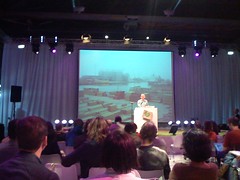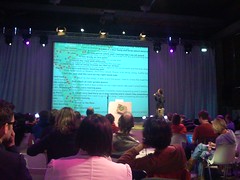Threading: the bleeding edge of communication
September 28, 2007 | CommentsI like this post from Dan, where he nails two screaming goblins to the plank of truth with a single swipe of his brain hammer:
- Why is threading not a standard part of the UI? The iPhone (which I'm using at the moment - expect a monster post some time soon) just does this, without any fuss... and it's beautiful. We've been so stuck in the "flat inbox" view of SMS for years that we consider it normal;
- On his point re upgrades to handsets: he's spot on, and I think this is one of the things which has slowed down the rate of progress of the mobile internet (when compared to the fixed internet);
I've heard a justification for the latter, told to me in confidence by someone from a handset vendor: that software and infrastructure to OTA updates of firmware exists now, but that it's awaiting a product manager brave enough to roll it out into a handset for which they take responsibility... the problem here being bonus structures. If a product manager launches a device that generates loads of recalls (i.e. has high-risk features), it's possible that they'll take a financial hit personally.
I'm not sure how true this is (though my source was in a good position to know ;)), but it's a lovely example of optimising behaviour around numbers if so.
PICNIC07: Urban Playgrounds, Federico Casalegno, MIT
September 28, 2007 | CommentsPICNIC07: Urban Playgrounds, Federico Casalegno, MIT
Exploring how people, info and tech evolve. Presenting 2 projects.
- The electronic lens, with the govt of Catalunya: how can we rethink how citizens and institutions communicate, using mobile devices? Retrieve info from local places using physical bookmarks etc. Looks like a fairly standard tag-real-world thingy;
- What is the bus stop of the future? A landmark customised by UGC apparently, with a screen owned by the transportation agency for braodcasting information. At the back was a 6m x 2m wall with LEDs. The metaphor: the more communication happens within the bus stop, the more activity there is in the garden. Quite cute.
PICNIC07: Urban Playgrounds, Matt Adams of Blast Theory
September 28, 2007 | Comments PICNIC07: Urban Playgrounds, Matt Adams of Blast Theory
PICNIC07: Urban Playgrounds, Matt Adams of Blast Theory
Artist working since 1991, making a range of artworks particularly game-based projects.
Shows "Can you see me now": using real-world runners controlled by players at laptops, to avoid being caught by virtual-world runners. Avatars communicate with their players by voice; players need to guide them to collect photos, using the cityscape as a field of play.
"Uncle Roy Is All Around You": exploring a meaningful connection between the fabric of the city and game play, using small city areas and tightly authored content.
These games are challenging to build and don't scale: this is the theme from a few of the speakers this morning. They need to learn about LocoMatrix :)
"Rider Spoke" in collaboration with Mixed Reality Lab of Nottingham Uni, launching October.
Piss, battery low so switching off until I find power. Which means no blogging of the rest of this or Mr Cerveny's talk... (as if mere written word can pretend to contain him...)
PICNIC07: Urban Playgrounds, Christian Nold
September 28, 2007 | Comments PICNIC07: Urban Playgrounds, Christian Nold
PICNIC07: Urban Playgrounds, Christian Nold
Does "participatory sensory mapping": what do you do with this data you can gather, how do you turn it into a political proposition? What are the tools we can use to rethink the space?
He blindfolds children and has them led along by someone else, using other senses (smell, etc.) for local area. Produces a sensory deprivation map, a set of experiences geolocated: beautiful. 50% of categorisations are negative, 22% neutral, 28% positive.
Turns this into getting kids involved with local politics: there's a road in front of the school full of traffic and smells.
Next project: lie detector + GPS unit, to create emotion maps. Tends to do these in areas of regeneration - e.g. Stockport. PDAs are good, but physical paper maps are nice because you can stand around them: they talk in a language people can understand.
Really really nice looking stuff :)
PICNIC07: The revolution in personal fabrication, Neil Gershenfeld
September 28, 2007 | CommentsPICNIC07: The revolution in personal fabrication, Neil Gershenfeld
Fablabs: in between the large digital fabricators at MIT, and the personal fabricators we will have in 20 years time. Costs less to send the means to create objects, than it does to send the objects themselves.
Shows $10m chip fab: fundamentally it spreads stuff around and bakes it. Contrast with the ribosome: assembler of amino acids, basically a digital machine. Shows a computer made from bubbles in fluid. Bits are carrying information, but also material. What's a digital revolution? Adding digitisation to phone systems (by Shannon) improved them. Von Neumann did the same for computers in the 50s; for old analog machines, the longer you ran them the worse an answer you got. Chip fabs are still fundamentally analogue. Not a computer connected to a tool, they should be the tool: bringing the programmability of the digital world to the physical world.
Started a class at MIT: How to make (almost) anything.
Shows off ScreamBody.
"Animals are underserved for their IT needs": Interpet explorer.
In a world of personal fabrication, you create technology for yourself, not for mass production.
Fablabs are a hack, they're not the real thing. Shows K&R with a PDP: the moment computer systems went timesharing. The Fablabs today are a PDP - at the time everything was anarchic and the PDP was in the middle of this mess; right now we're at the start of an era, with the labs getting faster, cheaper, and better.
Fablabs don't fit into current organisational structures: e.g. the Pentagon love this from a hearts and minds perspective, but they don't have an office to do tech research that doesn't involve blowing things up. "Anyone being able to make anything, anywhere breaks everyones organisational boundaries".